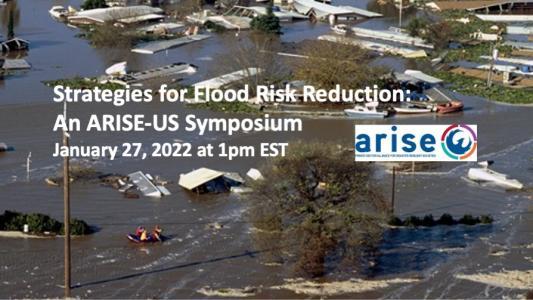ARISE-US Symposium

Event Description
January 27, 2022, at 1-3 pm EST
Format: virtual
Recordings of the Symposium: Click HERE
Flood risk (from rainfall, rivers, and coastal inundation) is growing, driven by the combined impacts of expanding settlement boundaries and climate change. These are exacerbated in some cases by unwise land zoning and lax code enforcement. The trend is stressing existing approaches to managing flood risk in many ways:
Flood risk is not effectively communicated to property and business owners. FEMA’s flood maps form the primary risk assessment in the US, but these only provide an area baseline rather than a continuing assessment, and they do not assess vulnerability at the individual parcel level.
There is generally no shortage of data on flooding hazards, but it is dispersed and in need of integration.
There is less data on vulnerability and materiality: we need to inventory buildings at risk to get a better view of exposures and vulnerabilities in any given area, and thus the cost-benefit of mitigation for specific properties.
Flood insurance is underwritten by the government through the NFIP program and may thus occasion moral hazard. NFIP payouts are capped at $250k for domestic properties; the program covers only a small proportion (less than 15% for single-family homes) of estimated flood losses of $7bn annually, and it is in any case underfunded.
Private insurance currently does little to address this gap, because the market is little-penetrated by insurers. There is a so far unfilled role for parametric insurance to mitigate flood losses.
Property owners complain that flood mitigation work does not always result in reduced insurance premiums.
There are often tensions between the proponents of “grey”, “green” and “blue” flood mitigation measures – when frequently a balance is needed, combining different options.
There is a tendency to prioritize drainage work over raising properties above flood levels even when the latter could be cost-effective and would be better at protecting the local tax base.
Too many homeowners and businesses think that infrastructure will save their specific property, so they don’t take their own other risk-mitigating steps. We need both top-down and bottom-up mitigation to improve resilience.
Potential damage to “lifeline” and service infrastructure is not fully considered when justifying flood mitigation investments.
There are significant equity issues in access to information on risks, and in mitigation spending.
Many city, state, and county governments do not know the many funding sources (government and others) that are possible for mitigation investment. However those sources have their own rules, so it becomes difficult to tie funding together.
To inform on these issues, ARISE-US hosted a web-based symposium on “Strategies for Flood Risk Reduction”. It featured public and private sector experts in the field and, with active participation from the audience, discussed the challenges and the solutions to them. The Symposium took place on January 27th, from 1-3 pm Eastern time.
The symposium had the form of two linked panels, to maximize discussion and dialog. One addressed the issues and the other, potential solutions. As with other ARISE-US symposiums, the Symposium initiated a program of actions as applicable from the discussion in the symposium itself, such as XXX
Who was this for?
This symposium offered access to the latest thinking on flooding DRR for insurers, governments, engineers and other risk managers, land/building owners, catastrophe modelers, financial services, and community organizations. Opportunities for follow-up activities and further contribution can be found XXX
Speakers
We had an extremely impressive slate of speakers and panelists. Here are those who spoke:
Ryan Miller, ARM-E, Principal, Critical Functions
Professor Melanie Gall, co-Director, Emergency Management, and Homeland Security Program, ASU
Tyler Ardron – VP at Risk Reduction Plus Group
Aidee Zamorano – Z-Zurich Foundation (Zurich Insurance)
Todd Bridges, Senior Research Scientist, Environmental Science, US ACE, and National Lead, Engineering with Nature
Chloe Demrovsky, President and CEO, DRI International, and Adjunct Professor, NYU
Paula Pagniez, Americas Lead, Climate and Resilience Hub, Willis Towers Watson, and FEMA National Advisory Council Member
Albert Slap, President, Coastal Risk Consulting
Aditya Ranade, Managing Partner, TwoDegreesAdapt
Roderick Scott, Flood Mitigation Industry Association
About ARISE-US:
ARISE is UN DRR’s vehicle for encouraging public-private collaboration in disaster risk reduction. Find out more at: https://www.ariseglobalnetwork.org/. ARISE-US is the US chapter of ARISE. To join ARISE-US (membership is free), contact Peter Williams, at [email protected], or Debbra Johnson at [email protected], or sign up at the global URL above.